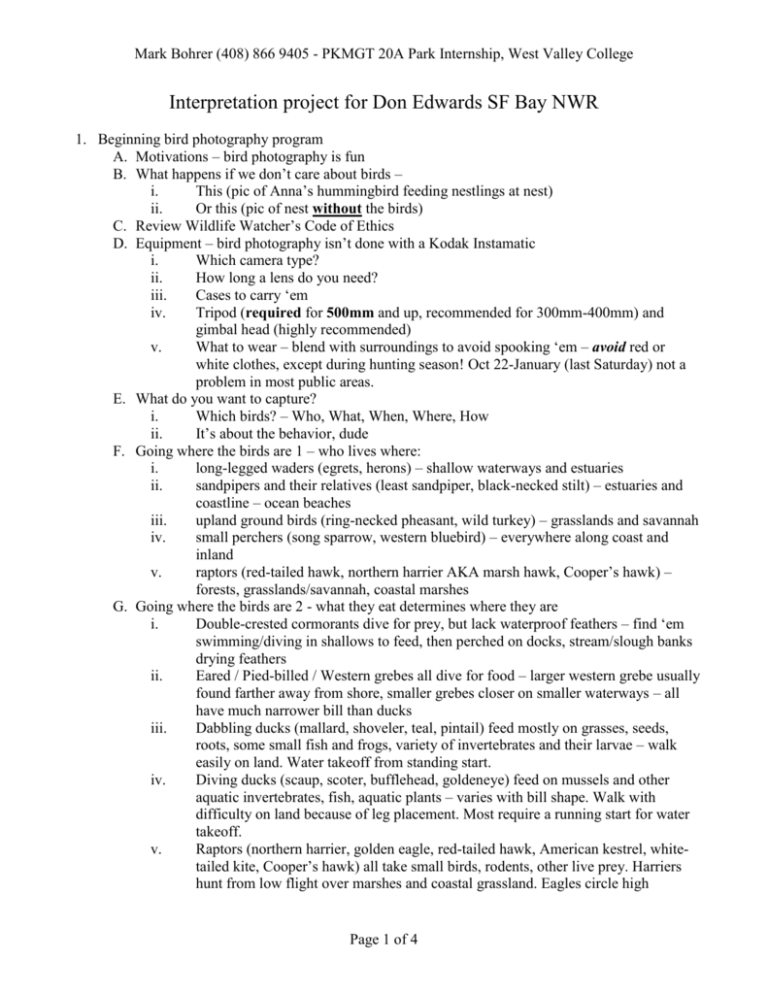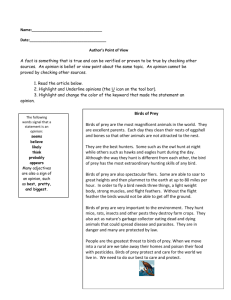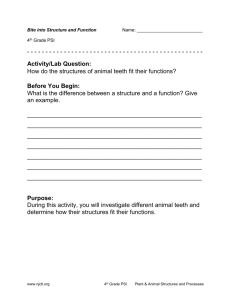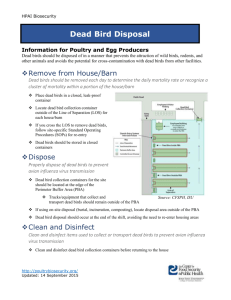Possible interp projects - Mark Bohrer Interpretation & Resource
advertisement

Mark Bohrer (408) 866 9405 - PKMGT 20A Park Internship, West Valley College Interpretation project for Don Edwards SF Bay NWR 1. Beginning bird photography program A. Motivations – bird photography is fun B. What happens if we don’t care about birds – i. This (pic of Anna’s hummingbird feeding nestlings at nest) ii. Or this (pic of nest without the birds) C. Review Wildlife Watcher’s Code of Ethics D. Equipment – bird photography isn’t done with a Kodak Instamatic i. Which camera type? ii. How long a lens do you need? iii. Cases to carry ‘em iv. Tripod (required for 500mm and up, recommended for 300mm-400mm) and gimbal head (highly recommended) v. What to wear – blend with surroundings to avoid spooking ‘em – avoid red or white clothes, except during hunting season! Oct 22-January (last Saturday) not a problem in most public areas. E. What do you want to capture? i. Which birds? – Who, What, When, Where, How ii. It’s about the behavior, dude F. Going where the birds are 1 – who lives where: i. long-legged waders (egrets, herons) – shallow waterways and estuaries ii. sandpipers and their relatives (least sandpiper, black-necked stilt) – estuaries and coastline – ocean beaches iii. upland ground birds (ring-necked pheasant, wild turkey) – grasslands and savannah iv. small perchers (song sparrow, western bluebird) – everywhere along coast and inland v. raptors (red-tailed hawk, northern harrier AKA marsh hawk, Cooper’s hawk) – forests, grasslands/savannah, coastal marshes G. Going where the birds are 2 - what they eat determines where they are i. Double-crested cormorants dive for prey, but lack waterproof feathers – find ‘em swimming/diving in shallows to feed, then perched on docks, stream/slough banks drying feathers ii. Eared / Pied-billed / Western grebes all dive for food – larger western grebe usually found farther away from shore, smaller grebes closer on smaller waterways – all have much narrower bill than ducks iii. Dabbling ducks (mallard, shoveler, teal, pintail) feed mostly on grasses, seeds, roots, some small fish and frogs, variety of invertebrates and their larvae – walk easily on land. Water takeoff from standing start. iv. Diving ducks (scaup, scoter, bufflehead, goldeneye) feed on mussels and other aquatic invertebrates, fish, aquatic plants – varies with bill shape. Walk with difficulty on land because of leg placement. Most require a running start for water takeoff. v. Raptors (northern harrier, golden eagle, red-tailed hawk, American kestrel, whitetailed kite, Cooper’s hawk) all take small birds, rodents, other live prey. Harriers hunt from low flight over marshes and coastal grassland. Eagles circle high Page 1 of 4 Mark Bohrer (408) 866 9405 - PKMGT 20A Park Internship, West Valley College H. I. J. K. overhead and stoop (dive) to take prey. Red-tails hunt from high perches – power poles and trees. Kites hover over open marsh or grassland and stoop to take prey. Cooper’s juveniles may hunt coastal grasslands – saw one dive on burrowing owls once at Shoreline. vi. Owls (burrowing owl, short-eared owl) usually nocturnal. Burrowing owl hunts small rodents, perches visibly near meadow grassland burrows during day. Shorteareds more likely to be found early and late in the day in winter, hunting small rodents over the marsh. vii. Sandpipers and relatives (willet, long-billed curlew, western sandpiper, greater yellowlegs, marbled godwit) will hunt in different places depending on bill-length and tide level. Least and western sandpipers usually occur in small flocks flying and eating together on shallow mud flats. Willets, curlews and yellow legs all hunt worms, crabs, and other invertebrates in shallow waters. American avocets and black-necked stilts hunt in shallows – in spring you see their precocial chicks pacing and hunting in shallows and mud flats. viii. Long-legged waders (egrets, herons) all hunt fish in the shallows – their long, slender bills and long, strong necks are well-suited for quick head-plunges these guys use to capture prey. ix. Savanah sparrows and other perching birds may hunt for seeds in the coastal grasslands. x. Gulls (ring-billed, California, western, herring, glaucous-winged) all take small fish, mussels, and other invertebrates from the Bay. xi. American white pelicans may be found dipping for fish in sloughs or shallow Bay waters year-round. California brown pelicans are most likely to be seen in winter and during spring migration. They dive to hunt fish in shallow waters. Why we need birds i. Importance to the food web – predators and prey ii. Overall maintenance of the ecosystem: a. Detritovores like turkey vultures are Nature’s garbage men, reduce organic wastes and clean up carrion b. Decaying eggshells return calcium, other nutrients to the ecosystem c. Chicks provide prey for other adult birds, mammalian predators (gray fox, coyote), nutrients to soil / aquatic areas from decomposition d. Adults provide population control of grasses, fish, shellfish (ex. mussels), small mammals and other birds (from burrowing owls, northern harriers, golden eagles and other raptors) e. Maintenance of ecosystem relationships not yet understood Why birds need the ecosystem i. Marsh and coastal grasslands provide places to roost and hide from predators ii. Marsh and coastal grasslands provide food Why humans need the ecosystem i. Water filtration for health of aquatic species and humans who consume some of them (fish). ii. Flood control for coastal areas iii. Salt and other mineral recovery Ethical photographic techniques – stay out of trouble, obey the law and protect the birds! Page 2 of 4 Mark Bohrer (408) 866 9405 - PKMGT 20A Park Internship, West Valley College i. L. M. N. O. P. Q. Bird comfort zones vary with human habituation, activity type (feeding nestlings, hunting, roosting, flying), species ii. Ethics 1 – never approach so close that you disturb or change their behavior. iii. Ethics 2 – Keep your distance from young birds in a nest to avoid adult abandonment iv. Federal and state law prohibit disturbing wildlife – any act causing birds to flush or move away from a nest, nesting site or rafting area, subjecting eggs or chicks to exposure, displacement from nest site or predation, or causing visible agitation or behavior alteration. f/8 and be there… or not: i. Isolating with narrow depth of field = largest lens openings ii. Use the highest ISO you can get with acceptable digital noise – with recent dSLRs this may mean 1600 to 3200 is still acceptable if you’re close enough iii. High ISOs and large lens openings = barely high-enough shutter speeds to freeze flight shots Shooting techniques i. Use the ethical photographic techniques described above ii. Approach slowly iii. Take ‘insurance’ shots from farther away iv. How close? Fill the frame, but don’t alter behavior a. move up while they’re eating or feeding b. gulls, ravens and egrets are easiest to approach closely v. Tripod-mounting essential for lenses 500mm and up vi. Hand-holding possible for zooms to 400mm, fixed-length 400mm f/4.0 or f/5.6 lenses vii. Tripods versus handheld shooting – pros and cons viii. Panning – tracking the bird in flight with the camera Composition – AKA shot design Ask a ‘native guide’ where they are and what they’re doing now If you lack a flesh-and-blood expert, consult a book – like Santa Clara Audubon Society’s Birding at the Bottom of the Bay. Photography in one or two field locations Back-end tasks: R. Transfer pictures from your memory card(s) to your computer S. Manage your pictures – use Lightroom, DigitalPro or some other image management program to make sure you can find your pictures later T. Enhance in Lightroom or Photoshop – a whole ‘nother seminar! Page 3 of 4 Mark Bohrer (408) 866 9405 - PKMGT 20A Park Internship, West Valley College 2. Adult program for beginning birders A. Goal is bird ID – and the fun of seeing them outdoors B. Bird habitat – where to find them C. Spotting a bird D. Observing: i. Fieldmarks ii. Calls iii. Size iv. Flying style E. Behavior i. What is bird doing right now – hunting, eating, feeding, flying, roosting for the night (diurnal) or day (nocturnal) ii. Seasonal – spring and fall migration, nesting, mating, raising young – altricial vs precocial F. Binoculars – choosing i. 7x35 best to start – 1st number is magnification, 2nd relates to brightness of image and how wide the magnified field is – larger 2nd number is better ii. Should be light enough to carry, not so heavy you leave ‘em at home iii. At least somewhat weatherproof and SEALED iv. Exotic brands – Leitz/Leica Trinovids, Swarovski v. Affordable, good brands – Nikon, Pentax, Olympus vi. The best pair is the one you have with you! G. How to watch: i. spot bird ii. keep your eye on it iii. swing bins up to observe iv. Focus v. Fix as many details of appearance as possible into memory H. Bird guides – your ID key i. Sibley’s regional field guides shows drawings of different poses (flying, perching) and plumages (breeding, nonbreeding, male, female) ii. Most other guides show limited photographs iii. No guide shows ALL plumage variations, but Sibley will get you there I. To list or not to list i. bird checklists help you remember what you saw and where, depending on how detailed your list is ii. Can add incentive to watch, building your birding experience, ability to recognize different birds iii. Competitive aspects may not be what you want Build sense of mystery! Page 4 of 4







